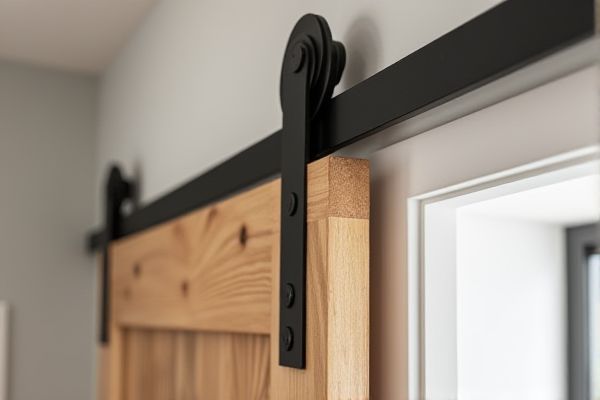
Barn door hardware offers a sleek, space-saving sliding mechanism that enhances your interior's aesthetic while maximizing floor space, unlike traditional hinge hardware which requires clearance for door swings and may occupy more room. Discover the advantages and considerations of each option to determine which best suits your home design needs by reading the full article.
Table of Comparison
| Feature | Barn Door Hardware | Traditional Hinge Hardware |
|---|---|---|
| Installation | Simple wall-mounted track system | Requires door frame and door preparation |
| Space Efficiency | Ideal for tight spaces, slides along wall | Requires swing clearance for door |
| Design Style | Rustic, modern, and industrial aesthetics | Traditional and classic door look |
| Durability | Heavy-duty steel track and rollers | Solid metal hinges, less wear on track |
| Noise | Generally quieter sliding operation | May creak with age and use |
| Cost | Mid to high price depending on material | Usually lower cost hardware |
| Maintenance | Requires occasional track lubrication | Minimal maintenance needed |
| Accessibility | Easy to open, good for wide openings | Standard accessibility, limited by swing |
Introduction to Barn Door Hardware and Traditional Hinges
Barn door hardware offers a modern, space-saving alternative to traditional hinge hardware, featuring exposed metal tracks and rollers that allow doors to slide smoothly along the wall. Traditional hinges pivot doors on a fixed frame, requiring clear space around the door to swing open, which can limit room layout options. You can enhance your interior design by choosing barn door hardware for a sleek, contemporary look or traditional hinges for classic functionality.
Key Differences Between Barn Door and Traditional Hinges
Barn door hardware typically features a sliding mechanism with a track system that allows doors to glide horizontally, unlike traditional hinge hardware which pivots doors open along a fixed axis. Barn door hardware requires overhead clearance and wall space for installation, whereas traditional hinges need door jambs and door frames for swinging movement. The aesthetic design of barn door hardware often emphasizes industrial or rustic elements, contrasting with the more conventional and discreet appearance of traditional hinge hardware.
Aesthetic Appeal: Modern vs Classic Design
Barn door hardware offers a sleek, industrial aesthetic that enhances modern and rustic interiors alike, creating a striking focal point with exposed metal tracks and rollers. Traditional hinge hardware delivers a classic, timeless look, seamlessly blending with conventional cabinetry and door styles through understated, concealed mechanisms. Your choice will significantly impact the room's style, either emphasizing contemporary minimalism or preserving traditional charm.
Space Efficiency and Room Utilization
Barn door hardware maximizes space efficiency by sliding along the wall, eliminating the need for the clearance typically required by traditional hinge doors that swing open into the room. This sliding mechanism allows for better room utilization, especially in smaller or narrower spaces where every square foot counts. Traditional hinge hardware consumes floor and wall space during operation, reducing overall furniture placement options and functional area.
Installation Process: Complexity and Requirements
Barn door hardware installation is generally simpler and faster, requiring a straight mounting track and rollers, often with minimal wall modifications, while traditional hinge hardware demands precise alignment of hinges and door frames, making it more labor-intensive and time-consuming. Barn door systems typically need sturdy wall support to bear the door's weight on the track, whereas traditional hinges rely on the door jamb for structural support. The installation of barn door hardware is ideal for DIY enthusiasts due to its straightforward mounting process, contrasting with the specialized carpentry skills often necessary for traditional hinge setups.
Durability and Maintenance Comparison
Barn door hardware often features robust materials like steel or aluminum, providing enhanced durability compared to traditional hinge hardware, which may wear out more quickly due to frequent opening and closing. Maintenance for barn door hardware is generally minimal, requiring occasional lubrication of rollers and tracks, whereas traditional hinges may need regular tightening and lubrication to prevent squeaking and loosening. Choosing barn door hardware can reduce long-term upkeep and extend the lifespan of your door installation.
Privacy and Soundproofing Considerations
Barn door hardware offers minimal soundproofing and limited privacy due to the door's sliding design and gaps between the door and wall. Traditional hinge hardware enables a tighter seal within the frame, providing enhanced acoustic insulation and improved privacy. For spaces requiring noise reduction and secure privacy, traditional hinged doors are a superior choice compared to barn doors.
Cost Analysis: Barn Door vs Traditional Hinge Hardware
Barn door hardware typically costs between $100 to $300 per track set, while traditional hinge hardware ranges from $5 to $20 per hinge, making barn doors a higher initial investment. Installation expenses for barn doors may be greater due to track mounting and wall reinforcement requirements, whereas traditional hinges often require minimal labor and standard door framing. Long-term maintenance costs for barn doors can be lower because of durable rollers and smooth operation, contrasting with traditional hinges that may require periodic tightening or replacement.
Best Applications for Each Hardware Type
Barn door hardware excels in spaces that require sliding functionality, such as closets, room dividers, or areas with limited swing clearance, making it ideal for modern or rustic interior designs. Traditional hinge hardware is best suited for standard doors in bedrooms, bathrooms, and entryways where full door swing and a secure latch are essential for privacy and security. Choosing between barn door and hinge hardware depends on the need for space-saving solutions versus conventional door operation and installation requirements.
Conclusion: Choosing the Right Hardware for Your Needs
Barn door hardware offers a sleek, space-saving solution ideal for modern interiors, while traditional hinge hardware provides classic durability and ease of installation. Your choice depends on factors such as available space, aesthetic preference, and frequency of use, with barn doors excelling in tight or contemporary spaces and hinges suited for conventional room setups. Evaluating these aspects ensures you select hardware that best meets your functional and design requirements.
 homyna.com
homyna.com